This trip, unlike most of the other fishing trips I have undertaken was a step into the unknown. I had no experience of Costa Rica, nor did I know anyone who had stayed or fished there, but I wanted to catch a rooster fish. I searched around for information, found Jackpot and did research asking for a list of references. Everybody praise Benn and his team. Benn is an ex-pat, so clearly understood just what I wanted. I had booked six days fishing and wanted to try lots of different techniques, but had no desire to go big game fishing where I thought I would just sat in a chair, have a rod passed to me to reel in as you see on the films. He understood and promised this wouldn’t happen.
Day 1 started by buying a licence at the marina for the week, then we went inshore fishing on Chloe Frijole heading north along the shore until we reached a river mouth and tried to catch pilchards for bait. Dom is more into fly fishing and spinning whereas I prefer bait and spinning, so he stood on the front of the boat casting whilst I tried to catch the sardines at the rear. Although we saw and tracked bait balls, they fish were not easy to catch as they were somewhat distracted by the jacks and spanish mackerel trying to eat them that were everywhere and with so much food, weren’t interested in Dom’s offerings.
Eventually we got enough and travelled a bit further up the coast after snook and the species I had travelled to catch, rooster fish.
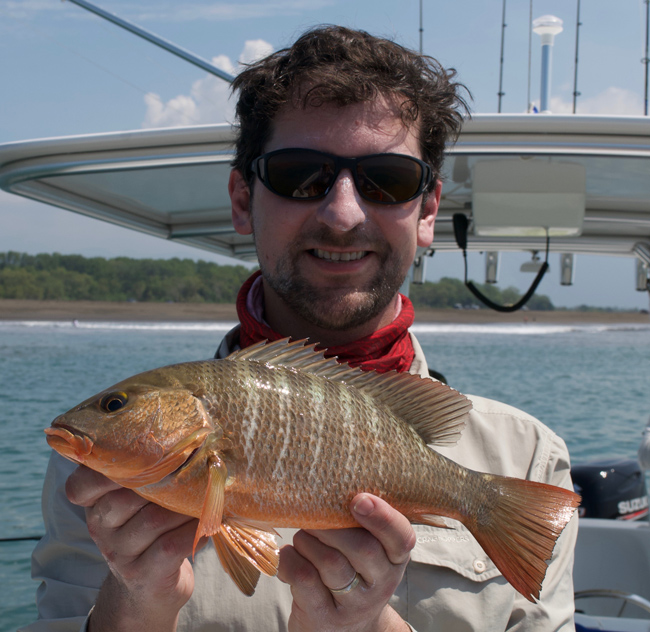 The first fish we caught was….a catfish which fought well on light tackle. We managed a few snapper, Dom had mangrove, yellow-tail and cubera whereas I only had mangroves. Then I lost a rooster fish at the side of the boat and Dom lost a giant needlefish (they grow over 10lbs) when it leapt and threw the hooks, a pattern that continued throughout the week.
The first fish we caught was….a catfish which fought well on light tackle. We managed a few snapper, Dom had mangrove, yellow-tail and cubera whereas I only had mangroves. Then I lost a rooster fish at the side of the boat and Dom lost a giant needlefish (they grow over 10lbs) when it leapt and threw the hooks, a pattern that continued throughout the week.
We were using circle hooks (which is mandatory for bait fishing) so it is necessary to wait for five seconds before winding to set the hook, but then, unlike tarpon fishing when you play them hard, you don’t here and I lost too many fish with the hook pulling out before I learnt.
 In the afternoon we switched to south of the marina and caught snapper species as before plus grouper, one of which we kept for dinner. I lost more fish in the afternoon, not helped by using an outrigger which didn’t break free well enough. I did hook one fish which we believed to be a big cubera snapper which simply stripped line from the reel as it plunged down into the reef and I could do nothing about it.
In the afternoon we switched to south of the marina and caught snapper species as before plus grouper, one of which we kept for dinner. I lost more fish in the afternoon, not helped by using an outrigger which didn’t break free well enough. I did hook one fish which we believed to be a big cubera snapper which simply stripped line from the reel as it plunged down into the reef and I could do nothing about it.
In the evenings, we ate across the road rotating between three restaurants where they would cook our fish to whatever method we wanted (reducing the cost as we provided the fish). The meals were always very good with everything freshly cooked and, on the whole, were superior to the pub food we get in this country.
One evening we were sitting by the balcony with a root dangling down from the plants above when a juvenile sloth climbed down, and it hung there watching us for several minutes. One of those never to be forgotten moments.

The next day, we were serenaded by a morning chorus of howler monkeys and birds as we left early again, but this time we were offshore fishing off Good Day. We also saw the most beautiful butterfly, the biggest I have ever seen.

Benn suggested we go to the mark Furung Bank, about 30 miles from the marina and try for sailfish.
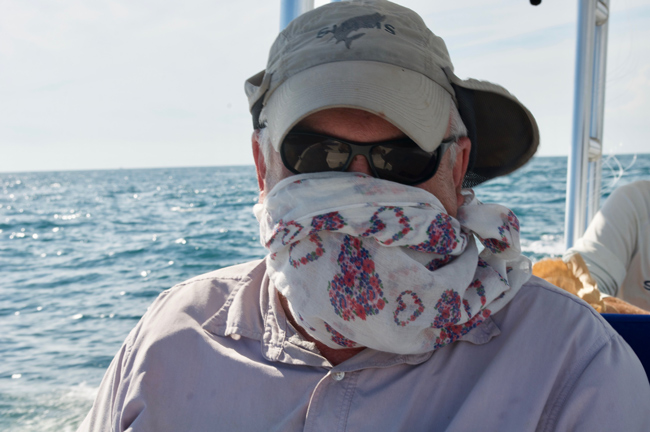 It was hot and to protect ourselves we had hats which covered our neck and ears, either with a shroud or a wide brim. Sunglasses are essential and a scarf to cover the rest of your face is advisable. You do look like a bandit from a cowboy film but it stops you burning. Don’t forget the factor 50 sun lotion too, I forgot to put in on the back of my hands one day and paid the penalty. Drink plenty too, Benn had two fridges on board stuffed with drinks which we could help ourselves to, and we did more than once an hour. This is not to be taken lightly. The water temperature 30 miles out was 81F, and when we got back to the cool of the marina in the evenings, it was still 30 – 35C.
It was hot and to protect ourselves we had hats which covered our neck and ears, either with a shroud or a wide brim. Sunglasses are essential and a scarf to cover the rest of your face is advisable. You do look like a bandit from a cowboy film but it stops you burning. Don’t forget the factor 50 sun lotion too, I forgot to put in on the back of my hands one day and paid the penalty. Drink plenty too, Benn had two fridges on board stuffed with drinks which we could help ourselves to, and we did more than once an hour. This is not to be taken lightly. The water temperature 30 miles out was 81F, and when we got back to the cool of the marina in the evenings, it was still 30 – 35C.
Benn took us big game fishing teaching us the knots, how to set the bait, how he prepared the teasers with different options, where to fish the bait and how to move it when fish come. Everything except unhooking the fish, and he then took the photographs too. He went through all the procedures and Dom and I both came away surprised at the complexity and attention to detail needed to be successful. This is totally different to how it is portrayed on television and so much more enjoyable. Everything he had promised.
There were rods with just teasers, rods with marlin baits, assortment of attractors and our rods baited with ballyhoo. The beaks and tails are removed to make them swim in a controlled direction, weighted to keep them the right way up. The trace is heavy gauge monofilament to prevent the bill from slicing through it, and even then you can feel how rough it is after catching a fish.
We search the sea looking for signs of fish. One is the pods of spinner dolphin numbering around 200 and is a sight not to be missed, but beneath them are other fish and tuna so an obvious place to look for sailfish.
The first sign of action is a bill rising from the water thrashing at the teasers. It is then you need to bring your bait alongside the fish as the teasers are removed, the fish will normally turn and take the bait. Once again you wait 5-7 seconds before winding to set the hook and then the fight starts. The fish usually leaps from the water repeatedly making the most spectacular fight, but in doing so it tires and the battle doesn’t last very long. What a spectacular fish displaying such vibrant colours!

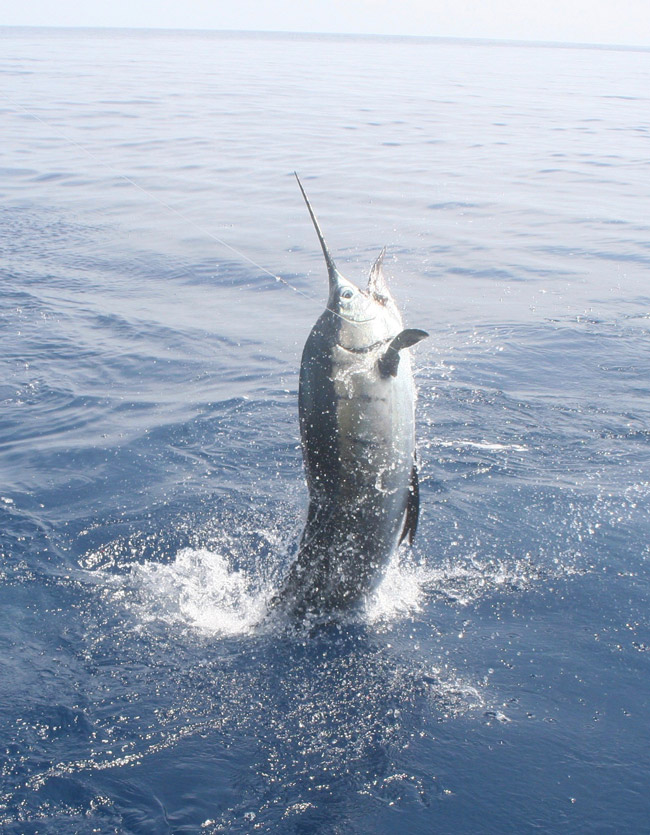
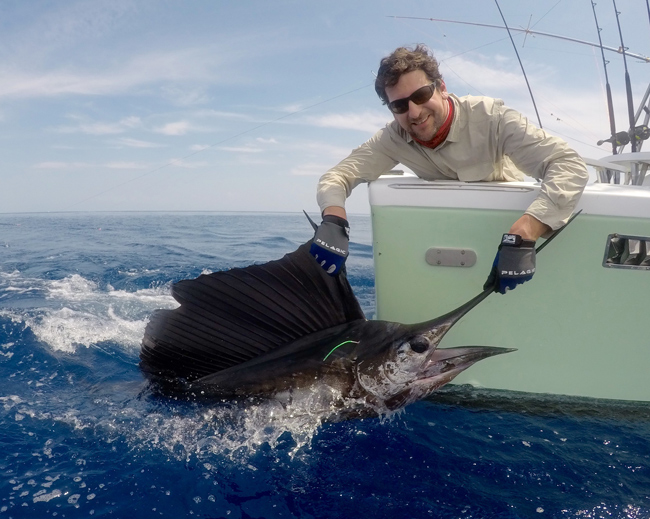 It is illegal to lift them into the boat for the regulation trophy shot, but you can bring them alongside and Benn took the pictures using a selfie stick while you hold them down in the water to speed recovery before being released. It is an experience you will never forget.
It is illegal to lift them into the boat for the regulation trophy shot, but you can bring them alongside and Benn took the pictures using a selfie stick while you hold them down in the water to speed recovery before being released. It is an experience you will never forget.
Each fish was tagged so scientists can learn about the movement and can then protect its breeding grounds, and we could even give them names which seemed a bit bizarre, but can add to the experience for those involved.

So Benn was as good as his word, we came back having learned a lot about this type of fishing which is just as involved as any other aspect of the sport.
 The next day we went offshore to mark EL20. We ran through a shoal of bonito and all our rods went off at once, I had two and a fish they call a tuna mackerel which looked very similar. We found a large pod of spinner dolphin with many yellow-fin tuna visible below and I had to try and catch one of these. Using a lighter spinning rod with only a 40lb trace I struck into the biggest sailfish of the week. It took about 30 minutes to get to the boat aided by great steering from the skipper Manuel, and eventually a 95lb fish was unhooked and tagged.
The next day we went offshore to mark EL20. We ran through a shoal of bonito and all our rods went off at once, I had two and a fish they call a tuna mackerel which looked very similar. We found a large pod of spinner dolphin with many yellow-fin tuna visible below and I had to try and catch one of these. Using a lighter spinning rod with only a 40lb trace I struck into the biggest sailfish of the week. It took about 30 minutes to get to the boat aided by great steering from the skipper Manuel, and eventually a 95lb fish was unhooked and tagged.
 In the afternoon we switched to reef fish some 200’ deep. The bait was pieces of fish and as the weight hit the bottom, you immediately had a take, but Benn said not to bring it up until you had a second fish on a little while later, as to bring the bait and lead up and down over this depth can be tiring, and we had several double hook-ups and many new species. Several didn’t recover from the pressure change and when we had caught enough for all our meals we stopped. It was such a shame as there were so many species but neither Dom nor I would kill a fish unnecessarily.
In the afternoon we switched to reef fish some 200’ deep. The bait was pieces of fish and as the weight hit the bottom, you immediately had a take, but Benn said not to bring it up until you had a second fish on a little while later, as to bring the bait and lead up and down over this depth can be tiring, and we had several double hook-ups and many new species. Several didn’t recover from the pressure change and when we had caught enough for all our meals we stopped. It was such a shame as there were so many species but neither Dom nor I would kill a fish unnecessarily.
One other highlight of the day was undoubtedly the pineapples that got sliced up at lunchtime. I am not keen on them in this country but out there, freshly cut they are to die for. If you had to choose between a marlin take and eating pineapple you would struggle to choose, they were that delicious.
Dom wanted to have a go at fly fishing for sailfish the next day. This involves using teasers to bring the fish in, gradually drawing them into he boat, and when close enough, Dom would cast a fly alongside the fish as the Jackson lifted the teasers from the water. The fish is allowed time to turn before the hook is set by pulling on the fly line. We had three rises from fish during the day. The first didn’t last long enough to cast a fly to but I caught it on bait, the second felt the hook which didn’t set, and the third came back three times to take the fly, and on the third occasion the fly seemed to strike home, as the line streamed from the reel we all cheered, then the fly flew out. It wasn’t going to come back again so we flicked a ballyhoo out which the fish immediately took and Dom was able to wind down and catch the fish, disappointed not to have it on the fly. It was just so exciting seeing the fish come within a few feet of the stern where we could all see it. It was like stalking sailfish with a fly
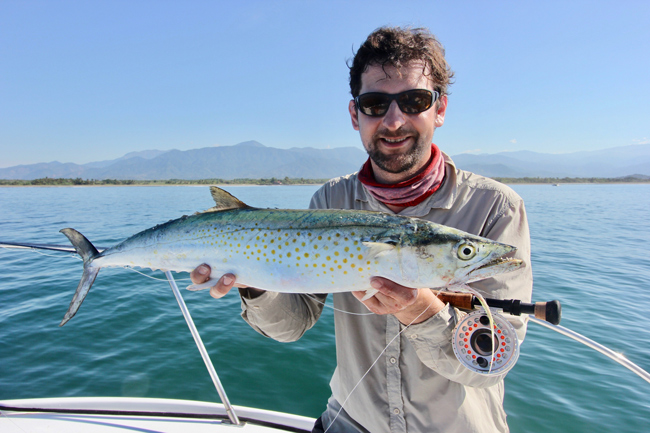 The next day we were back inshore fishing, and again went off to catch bait. At one point we could see five bait balls, but struggled to catch a fish as they were being attacked mainly by spanish mackerel and jacks. The mackerel have excellent teeth and just taking the fish that took our bait and the lures that Dom was using, everything disappeared; one even bit through a swivel leaving just the top half. I have never seen metal swivels bitten through before.
The next day we were back inshore fishing, and again went off to catch bait. At one point we could see five bait balls, but struggled to catch a fish as they were being attacked mainly by spanish mackerel and jacks. The mackerel have excellent teeth and just taking the fish that took our bait and the lures that Dom was using, everything disappeared; one even bit through a swivel leaving just the top half. I have never seen metal swivels bitten through before.
The day was slow and we managed jack cravelle which are great fighters and mangrove snapper. Dom managed the local fish known as a bass which was the dinner for the night.
 The crew were highly amused when we said we were going fishing when the boat landed. We showed them the tackle we were going to use in a “stream” alongside the harbour. Coarse tackle with size 12 to 16 hooks, little bits of shrimp and a BB shot on 4lb line, Dom had his LRF tackle.
The crew were highly amused when we said we were going fishing when the boat landed. We showed them the tackle we were going to use in a “stream” alongside the harbour. Coarse tackle with size 12 to 16 hooks, little bits of shrimp and a BB shot on 4lb line, Dom had his LRF tackle.
We had a couple of hours before sunset yet added quite a few species to make out total 29 for the holiday. The highlight was the sergeant major I caught which Dom photographed with his General (a 6” toy which make the fish look huge) to add a touch of humour to the proceedings, much to everyone’s amusement the next day.

The last day we decided to go all out for the roosterfish I had come for and had managed to avoid apart from the one I lost. We caught sardines and lookdown which are meant to be the preferred bait for roosters.
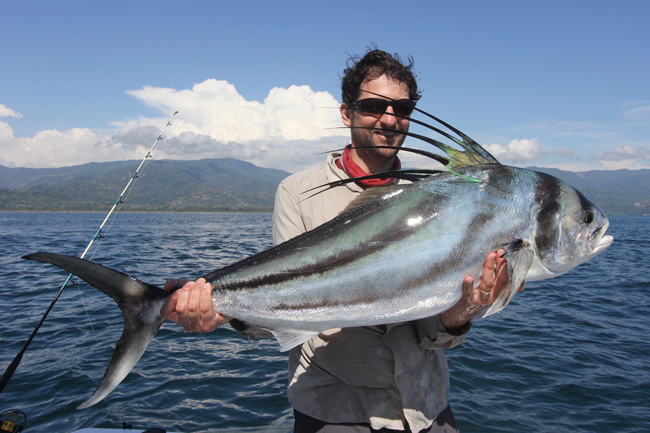 Good Day went about 20 miles south where some rocks protruded from the surface which he said had been productive before and were not heavily fished due to the distance from the marina. Finally, after about 30 minutes I caught my rooster fish and it was as beautiful as I had hoped. It wasn’t huge but that never matters to me. Then I caught another, it was a bit like buses all coming at once. Dom then caught the next one that was a klonker, all of 40lbs. We also hooked several of the big needlefish but we just couldn’t get the hooks to hold.
Good Day went about 20 miles south where some rocks protruded from the surface which he said had been productive before and were not heavily fished due to the distance from the marina. Finally, after about 30 minutes I caught my rooster fish and it was as beautiful as I had hoped. It wasn’t huge but that never matters to me. Then I caught another, it was a bit like buses all coming at once. Dom then caught the next one that was a klonker, all of 40lbs. We also hooked several of the big needlefish but we just couldn’t get the hooks to hold.

Finally, Manuel said we had less that half an hour to go when Dom and I had a double hook up, we both had a rooster each and it seemed the perfect way to end the trip which had exceeded our expectations.
One last thing to note is on the Pacific side of the country if you are booking a trip is there are two seasons, dry and wet. It is best from the start of November to the end of March, and Benn takes his boat out of the water for annual maintenance in August and September as these are the worst months.
If you fancy this trip you should contact Benn on www.jackpotsportfishing.com If you want to make it more of a family holiday, the unabridged version can be read on the "Two Travellers, One Rod" section of the webpage